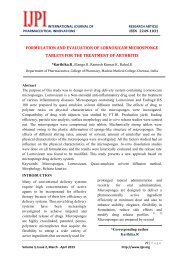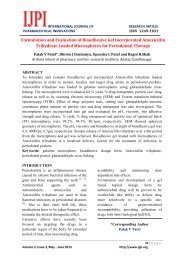IMMUNO MODULATORY ACTIVITY OF THE ALCOHOLIC ... - IJPI
IMMUNO MODULATORY ACTIVITY OF THE ALCOHOLIC ... - IJPI
IMMUNO MODULATORY ACTIVITY OF THE ALCOHOLIC ... - IJPI
- No tags were found...
You also want an ePaper? Increase the reach of your titles
YUMPU automatically turns print PDFs into web optimized ePapers that Google loves.
INTERNATIONAL JOURNAL <strong>OF</strong>RESEARCH ARTICLEPHARMACEUTICAL INNOVATIONS ISSN 2249-1031<strong>IMMUNO</strong> <strong>MODULATORY</strong> <strong>ACTIVITY</strong> <strong>OF</strong> <strong>THE</strong> <strong>ALCOHOLIC</strong> EXTRACTS <strong>OF</strong>MIMOSA PUDICA (LINN) IN MALE WISTAR RATSJohn Wesley J*, C. Suresh Raman Nadar, N. ChidambaranathanDepartment of Pharmacology, S. A. Raja College of Pharmacy, Tamil NaduAbstract:The Immuno modulatory effect of alcoholic extract of the various aerial parts of mimosapudica (Linn) Mimosaceae was investigated in male wistar rats. The assessement of immunomodulatory activity was carried out by various hematological and serological test. Futherimmuno modulatory activity was studied by Cell Mediated Immune Response (CMIR)measured by delayed type of hypersensitivity reaction to SRBC and humoral immuneresponse (HIR) measured by heamagglutination antibody titer. The alcoholic extractsignificantly enhanced humoral as well as cell mediated response in normal and treated rats.The results indicate the potential of mimosa pudica (Linn) as an immuno modulatory agent.Keywords: Mimosa Pudica, cell mediated, humoral.INTRODUCTION:Immuno modulation is a process that canalter the immune system of an Organismby interfering with its function. Ifenhancement of immune reactions namedas immune modulatory, then immunosuppresant implies mainly to reduceresistance against infection on account ofhemotherapeutic factors [1, 2] . Immunomodulatory agents may selectively activateeither cell mediated or humoral immunity.The primary target of the immunomodulatory compounds is belived to be themacrophages, which play a key role in thegeneration of immune response. Numberof Indian medicinal plants and various(“Rasayanas”) (charak samhita, 1000 B.C)have been claimed to possess immunomodulatoractivity. Rasayanas are group ofnon toxic herbal drug preparations thatstimulate the immune response of thehuman.M. Pudica (Linn) is a sensitive plant,creeping annual or perennial herb belongsmostly to the subtropical areas of southernparts of India. The Juice of Fresh leavesare mixed with Ghee is used in thetreatment of inflammation of the skin [3] .The leaves are also used for externalapplications for wounds and ulcers [4] . Theeffect of M. Pudica on the immune systemat various levels. i.e hematopoiesis,unspecific mechanisms and cellularresponses has not been extensivelystudied. Therefore the object of present*Corresponding AuthorJohn Wesley JVolume 3, Issue 4, July − August 201341 | P a g ehttp://www.ijpi.org
INTERNATIONAL JOURNAL <strong>OF</strong>RESEARCH ARTICLEPHARMACEUTICAL INNOVATIONS ISSN 2249-1031study was to investigate the immunomodulatory effect of the alcoholic extractof mimosa pudica.MATERIALS AND METHODS:M. Pudica (Linn) is a red brown prickly,crowded annual herb. It forms a denseground cover, preventing reproduction ofother species. It’s a wide land fire hazardwhen dry. The healthy plant material wascollected from local areas of KanyakumariDistrict in the month of August toSeptember. Specimens at voucher number4214 was deposited in the herbarium of thebotany department at the American collegeMadurai. Samples are dried in shade for 15days and reduced to moderately coarsepowder mechanically.EXTRACTION PROCEDURE:Powdered material of M.Pudica wassubjected to extraction using 95% of ethylalcohol. The extract was concentratedunder reduced pressure according toqualitative chemical tests. Extract wasfurther fractionated into pet ether (60-80º)all the extracts are concentrated undervacuum evaporation (Roteva, Equitran).Percentage yield of alcoholic (9.6%) wasreported.Phytochemical Investigation:The quatitative chemical test of alcoholicextract of M.Pudica was carried out usingstandard procedure to determine thepresence of various phytochemicals.Alcoholic extract was subjected toquantitive estimation of glycosides andsapponin content[6-8] . Tests show thepresence of flavanoids and absence ofglycosides.Experimental protocolsMale wistar rats (180-220g) were used forthe activity. They were housed underVolume 3, Issue 4, July − August 2013controlled conditions of light dark cycle(12:12) and temperature (25 ± 2°c) priorapproval by institutional ethics committeewas obtained for conduction ofexperiment.Acute toxicity studyThe acute toxicity study of alcoholicextract was evaluated in male wistar rats.The animals were fasted overnight prior tothe acute toxicity study. Different groupscontaining 2 rats in each were orallyadministered with alcoholic extract at 0.5,1, 1.5, 2 and 3 mg/kg p.o respectively.Mortality and general behaviour of theanimals were observed continuously forinitial four hour and then at 24 hours and48 hours after dosing. The parameterobserved and recorded were sedation,grooming, loss of righting reflex,respiratory rate and convulsion. 1/10 th oflethal dose was taken as the screening dose[8, 9] .AntigenSRBC – The blood was withdrawn fromthe external jugular vein of sheep. It wasmixed with alsevier’s solution in 1:1proportion and was stored at 4°c.Cell – mediated immune response toSRBC delayed type hyper sensitivityAnimals were divided into 4 groups eachcontaining 6 animals immunized on day 0by i.p administration of 0.5 x 10 9SRBC/ml. The suspensions of solventdried extracts of alcoholic were preparedin gum acacia solution (0.5%) andadministered orally to rats from day 1 today 13 at a dose at 200 mg/kg bodyweight.At the same time control group received0.5% gum acacia solution. Animals fromall groups were antigenically challengedby subcutaneous admisintration of42 | P a g ehttp://www.ijpi.org
INTERNATIONAL JOURNAL <strong>OF</strong>RESEARCH ARTICLEPHARMACEUTICAL INNOVATIONS ISSN 2249-10310.25X10 9 SRBC /ml into the right hindfood pad of the rats. On day 13, DTHresponse was measured after 48 hrs withrespect to increase in paw volume byplethysmometer (UGO Basile, Italy). Thechange in the volume of the left hind pawinjected similarly with phosphate bufferedsaline served as control. The percentageincrease in the volume of the paw inalcoholic treated group was considered asan index of cell mediated immune[11, 12].responseHumoral immune response[13, 14](haemagglutination antibody titer)Humoral immume response was measuredby haemagglutination antibody titremethod on days 13 and 20. Animals weredivided into 5 groups, each groupcontaining 6 animals. Group I served ascontrol and group II and III were treatedwith alcoholic extract of mimosa pudica(linn) at a dose of 200mg/kg and 400mg/kg for 13 days and each animal wasimmunised with 0.5 x10 9 SRBC/ml, by i.proute including control group on day 0. Onday 13 and 20, blood samples werecollected from the retro-orbital plexus ofrats of all the groups and serum wasseparated. In the wells of micro-titratingplate, 25μl of serum was serially dilutedwith the same amount of phosphate suffersaline (PH 7.4) to get successive 2 folddilution so that antibody concentration inany of the wells was half that of previous.The minimum dilution of serum (1/2) wasranked as 1. Each dilution with 25μl ofSRBC suspension (0.025 x 10 9 cells/ml)was incubated at 37ºc for one hour. Thehighest rank number of the serum dilution,that exhibited agglutination wasconsidered as antibody titre. The initiallyVolume 3, Issue 4, July − August 2013observed antibody titre was considered asprimary humoral immune response whilethe observation on secondary consideredas secondary humoral immune respose.Results and DiscussionAdministration of Mimosa pudica plantextract has been reported to increaseproduction of circulating antibody titre.Alcholic extract of mimosa pudica linnwas evaluated at a dose of 200mg/kg and400 mg/kg for immunomodulatoryactivity. The DTH response to SRBCcorresponding to cell mediated immunity& haemagglutination antibody titre forhumoral immunity were measuredrespectively as shown in Table No 1 and 2.The results indicate that daily treatment ofrats with alcoholic extract showed asignificant elevation in the humoral as wellas cell mediated immunity. The humoralimmune response has been assessed byestimating the antibody levels in the rats.The humoral immunity involvesinteraction of B cells with antigen andtheir subsequent proliferationdifferentiation into antibody secretingplasma cells. SRBC have been used asantigenic material for initiating theantibody formation and subsequently thesame was titrated with SRBC byhaemagglutination method.The reaction resulted into an increase inthe paw volume which was considered asan index for DTH or cell Mediatedimmune response on the other handalcoholic extract on cell mediated immuneresponse produced slightly significantdecrease in the paw volume.ConclusionIn the presence study the alcoholic extractof Mimosa pudica plant on cell mediated43 | P a g ehttp://www.ijpi.org
Mean Increase in paw vol.(%±SEM)INTERNATIONAL JOURNAL <strong>OF</strong>RESEARCH ARTICLEPHARMACEUTICAL INNOVATIONS ISSN 2249-1031immune response to SRBC and Humoralimmune response showed positive immunemodulatory activity. It is important to notethat Mimosa pudica may have immunestimulant and immune suppressant activitydue to other phytochemicals. The presentinvestigation demonstrate immunemodulatory activity of alcoholic extract ofmimosa pudica thus have tremendousfuture potential for developing newpharmaceutical product with specificpharmacological activity.AcknowledgementsAuthors are greatly thankful to thedepartment of pharmacology for providingfree access to their facilities to carry outresearch work.Table No. 1- Effect of the alcoholic extract of mimosa pudica linn. On Delayed typeHypersensitivity reaction in the ratsGroup SubstanceDoseMean Paw volume (mm)(mg/kg) 24h 48h 72h 96hI Control (Normal saline) - 5± 0.25 5.12±0.25 5.25±0.15 5.26 ±0.13II Test extract I 200 4.8±0.9 5.23± 0.99 5.9 ±0.03 5.98± 0.24*III Test extract II 400 5.63±0.53 4.5±0.36* 5.8±0.03 6.0±0.24The values are mean± SEM, P
Humoral Immune Response.(Mean Antibody Titer Values)INTERNATIONAL JOURNAL <strong>OF</strong>RESEARCH ARTICLEPHARMACEUTICAL INNOVATIONS ISSN 2249-1031Table No.-2 Effect of Alcoholic extracts of Mimosa pudica linn. On hameagglutination titrein ratsGroupsHumoral Immune response mean antibody titerPrimarySecondaryControl 08.70±0.08 11.07±0.16Test extract I-200mg/kg 10.61±0.09* 13.49+0.18*Text extract II-400mg/kg 12.3±3 0.21* 14.52±0.29*The values are Mean ± SEM, P
INTERNATIONAL JOURNAL <strong>OF</strong>RESEARCH ARTICLEPHARMACEUTICAL INNOVATIONS ISSN 2249-1031References1. Hennessey L R, Baker J R. ClinicalImmunology. 8th Ed. New Jersey:Lange; 1994: 781.2. Lin Bi-Fong, Chiang Bor-Luen,Lin Jin-Yuarn. Int'Immunopharmacol. 2005; 15(4):711-22.3. Kirtikar-K R, Basu B D. IndianMedicinal Plants.2nd ed. 1996;3:2056-58.4. Pal D C, Jain S K. Tribal Medicine.1st ed. Naya Prakashan;1989:57T-5. Varier VPS. Indian MedicinalPlants .Orient - Longman; 1994;h1-21.6. Gupta A K. Quality Standards ofIndian Medicinal Plants. ICMR;New Delhi: 2003; 62.7. Rajpal V, Standardisation ofBotanicals. Eastern Publisher :New Delhi:2004; 41-428. Ghosh M N, Fundamental ofExperimental Pharmacology. 2nded. Scientific Book Agency,Kolkata: 1994; 153-58.9. Joharapurkar A A , Zamad S P,Wanjari M M , " Umathe S N.Indian J Pharmcol. 2003; 35:232-10. Mediratta P K, Sharma KK, Singh S. J /Ethnopharmacol.2002; 80: 15-20.11. Bhattacharya S K, Bhattacharya A ,Chakrabarti A.Indian J Exp Bio.2000; 38:119-28.12. Mitra S K, Gupta M, Sharma D NK. Phytotherapy Res.1999;13(4):341-43.13. Fulzele S V, Saturwar P M, JoshaiS B , Dorle A K. Indian JPharmacol.2003;-35: 51-54.14. Tatiya A.U, surana S.J khope S.D,Gokkale S.B.Phytochemicalinvestigation and Immunomodutory activity of Amaranthusspinosus linn. Indian J. pharm Edu.Res. 41 (4) Oct – Dec, 2007.Volume 3, Issue 4, July − August 201346 | P a g ehttp://www.ijpi.org
















